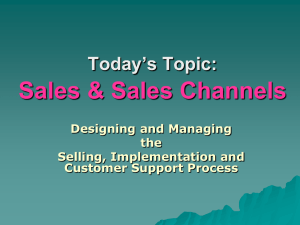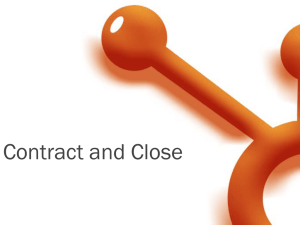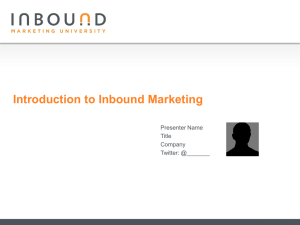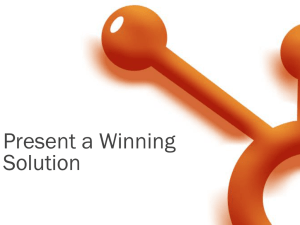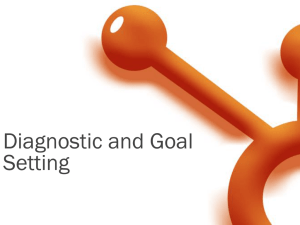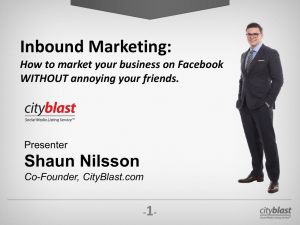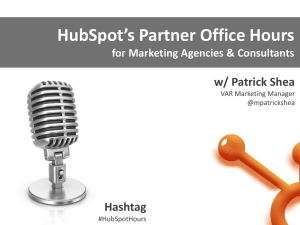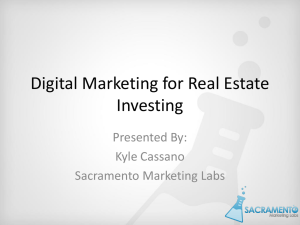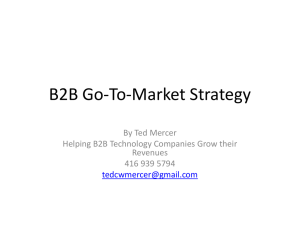Marketing & Sales - Stevens Institute of Technology
advertisement
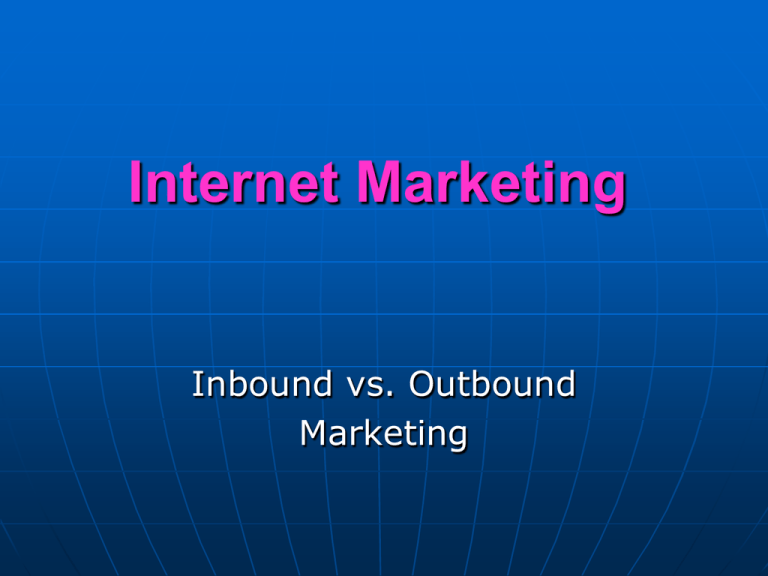
Internet Marketing Inbound vs. Outbound Marketing Course Schedule The Marketing Function (Lenovo) Sales & Sales Channels (GolfLogix) Internet-based Marketing (HubSpot) R&D: Product Development (Guidant) Operations (Crocs) Product Launch (Invisalign) Final Exam on Product Launch (Emotiv) Marketing: Learnings Elements of the Marketing Mix (C+4P) Basis of mix decisions: market & financial objectives and competitive advantage Importance of product positioning Positioning factors: - positioning with? (target customers) - positioning against? (relevant competitors) - desires & fears of positioning target - positioning content (differentiators,benefits) Promotion (marcomm): communicating to the marketplace to raise awareness and interest Sales Channels: Learnings The basic sales functions: (promotion), selling, fulfillment, and service Channel value-added: Higher and lower valueadded channels; value-added functions Specific channel options: direct (multiple types), OEM, integrator, VAR/VAD, distributor, dealer/retailer, etc Channel decision criteria: considerations in matching products, customers, and channels Channel economics: channel margin, profit Channel conflict: coordinating multiple channels HubSpot Case Summary Timeframe is 2009 HubSpot was founded in 2006; now has ~1000 customers Sells “inbound marketing” software that businesses use in their marketing/promotion efforts HubSpot has built its business by (exclusively) using inbound marketing techniques and its own products/tools To grow it’s business further, it faces questions about which customer segment to target, how to generate customer interest/contact, and which of the “interested” customers to pursue… …and whether to engage in outbound marketing Mix elements: Promotion Branding (creating a company or product “image”) Advertising (multiple media; paid and free) Direct marketing (mail, catalog, telemarketing, internet) “Reference” customers (testimonials) Public relations Industry relations (trade orgs, industry analysts,…) Trade shows and events Inbound marketing via internet … Inbound vs. Outbound Marketing Outbound (traditional) marketing “pushes” promotional information about the company and its products out to customers - mass and targeted advertising - trade shows and events - direct mail, etc Inbound marketing “pulls” customers and tries to get them interested enough to contact the company on their own initiative -search engines - blogs - social media, etc Assignment Questions Which customers should HubSpot target: Owner Ollies or Marketer Marys? Why? (see next chart for things to consider in making a decision) Does HubSpot have the right set of products for the chosen target customers? If not, what changes should they make? What are the positives-and-negatives of HubSpot’s software-as-a-service pricing strategy? What benefits would undertaking some outbound marketing have for HubSpot? What outcomes, if any, could outbound marketing deliver better than inbound marketing? (see second following chart, AIDA, for some hints) Selecting Target Customers: some considerations Segment size and revenue opportunity Customer benefits Customer interest (incl. current relationships) Customer ability-to-pay and leverage Competition/market coverage Sales issues: sale time/complexity, cost, channel and associated profit margin Cost to serve/support Customer loyalty/lock-in Customer lifetime value Strategic value AIDA Marketing Model Attention capture customer’s attention; create awareness of the company and/or product Interest create interest in the product’s features, benefits or value Desire customers want it and/or feel that they need it Action customer takes action; buys the product Reading for Next Class Guidant: Cardiac Rhythm Management Business (A) Guidant: CRMB in 1997 Guidant spun-off from Eli Lilly in 1994 Guidant is a medical device company CRMB is a division of Guidant CRMB profitable in 1996 (see Exh. 1A, income statement) Two product lines: - pacemakers (brady - for slow heart beat) - defibrillators (tachy - for fast heart beat) Guidant case….cont’d CRMB is the market share leader (#1) in tachy (hint: identify the key factors in their success) CRMB is a follower (#4) in brady Significantly revised their tachy new product development processes in the early/mid 90’s Decision on new R&D initiatives (additional investment in brady or atrial fibrillation or congestive heart failure?) Assignment for Next Class List the dozen or more changes Guidant/CRMB made to its tachy product development process; which three do you think had the greatest impact, and why? Does Guidant/CRMB have the financial resources to pursue new initiatives? What objectives (decision criteria) should CRMB use in making the decision to invest more in its brady business? What are the positives-and-negatives of CRMB devoting additional resources to the “brady” business in order to improve its brady market position and financial performance? (identify at least five of each) Guidance for Homework You will have to speculate which product development process modifications had the greatest impact….think about what would be most influential in getting the right product to the market quickly and efficiently In identifying the positives-and-negatives, consider market, technology, competitive and financial aspects
